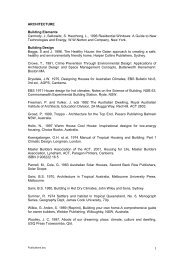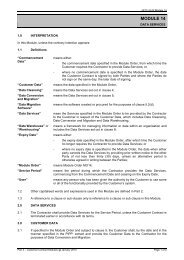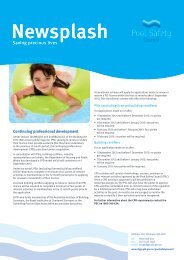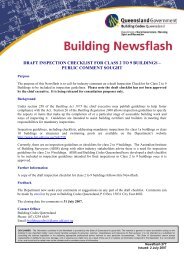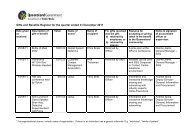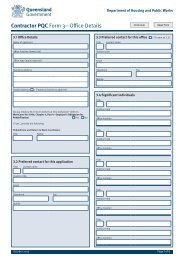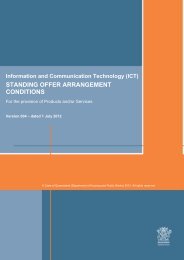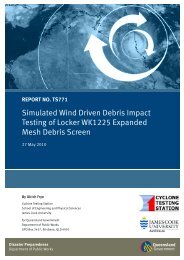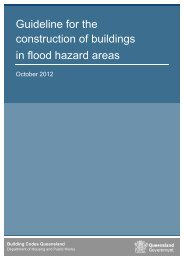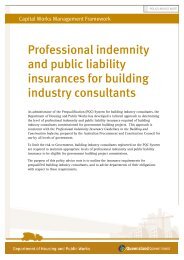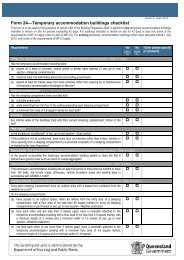Guideline - Department of Housing and Public Works - Queensland ...
Guideline - Department of Housing and Public Works - Queensland ...
Guideline - Department of Housing and Public Works - Queensland ...
You also want an ePaper? Increase the reach of your titles
YUMPU automatically turns print PDFs into web optimized ePapers that Google loves.
Step 7: Route capacity<br />
Determine the capacity <strong>of</strong>, <strong>and</strong> travel time along, the evacuation routes.<br />
The capacity (people/hr) <strong>of</strong> the evacuation routes will vary depending upon route conditions. A range <strong>of</strong> route<br />
conditions, normal <strong>and</strong> disrupted <strong>and</strong>, if appropriate, enhanced <strong>and</strong> blocked should be examined.<br />
Where the time necessary for evacuating the community is greater than six hours, for the normal route condition,<br />
determine the appropriate level <strong>of</strong> emergency management intervention to achieve an evacuation within<br />
six hours. Determine the enhanced capacity <strong>of</strong> the evacuation routes.<br />
Identify hazards which may block the evacuation route. Determine an alternate means <strong>and</strong> the rate <strong>of</strong> evacuation.<br />
Route capacity should be assessed individually for each community. The capacity is <strong>of</strong>ten controlled by the capacity<br />
<strong>of</strong> the intersection.<br />
Step 8: Route vulnerability<br />
Quantify the vulnerability to hazards which may block the evacuation route.<br />
The route vulnerability can be quantified in terms <strong>of</strong> the likelihood <strong>of</strong> occurrence, for example, a road flooded at a<br />
creek by a Q20 flood.<br />
Route conditions<br />
‘Normal’ - Fine weather with normal traffic control.<br />
‘Enhanced’ - Emergency agencies intervene to increase the route capacity. Several options are available. These<br />
include: ensuring a minimum number <strong>of</strong> people per vehicle; banning vehicles towing caravans <strong>and</strong> trailers; traffic<br />
control at intersections; both lanes in one direction.<br />
‘Disrupted’ - Heavy rain with possible vehicle break-downs <strong>and</strong> traffic accidents. Other disruptions may occur<br />
depending upon location. These include: traffic light failure; fallen trees; <strong>and</strong> localised l<strong>and</strong> slips or flood water over<br />
road but still trafficable with care. In this condition the route capacity is reduced <strong>and</strong> possibly blocked until emergency<br />
personnel clear the obstruction. In this case the capacity may be described as people/hour plus a delay period in<br />
hours to remove the hazard.<br />
‘Blocked’ - Route is closed by flood waters or large scale l<strong>and</strong>-slip <strong>and</strong> cannot be cleared in the evacuation period.<br />
An alternate route or means <strong>of</strong> transport needs to be identified <strong>and</strong> the route capacity determined.<br />
24 |<br />
Disaster Management Planning <strong>Guideline</strong><br />
Mitigating the Adverse Impacts <strong>of</strong> Cyclone – Evacuation <strong>and</strong> Shelter



